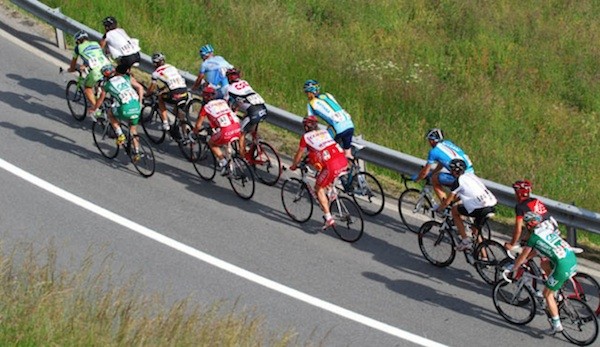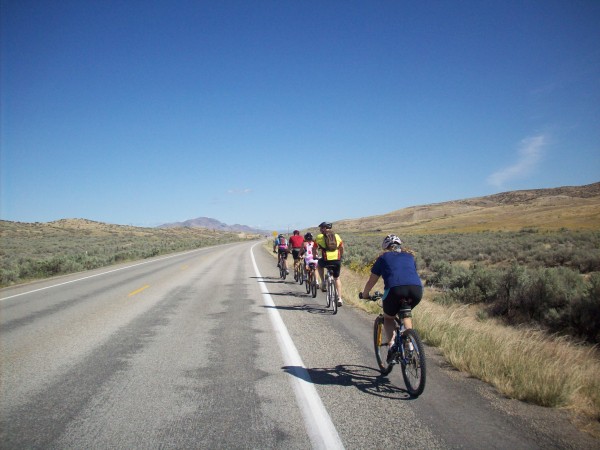You have the bike, and done the miles. You’re dressed in the right gear, understand the culture, and look like a cyclist. With all the cycling clubs, benefit and charity rides out there, there’s no reason to avoid group riding. Here are a few tips on group ride etiquette to boost your confidence to get out there and ride with a group.

Just Like You
Not knowing what to expect can be intimidating, but cyclists are just like you. Homemakers, laborers, bookkeepers, students, old, young and everything in-between. Some fit, some — not so fit. There’s no need to be intimidated, it’s not a competition. Everyone’s out there for fun. Group riding is camaraderie, adventure, laughter, feeling fit, and being surrounded by people with like minds. Understanding what’s expected makes you feel welcome, and a part of the group.
Two-by-Two
On country roads, or highways with little traffic, casual group rides might consists of two lines, with riders two abreast (this is called a paceline). Your handlebars should be parallel with each other, bar to bar, with no more than about a 12-to-18 inch gap between your bars, but closer is better. If you’re comfortable with a few inches it’s best. Maintain the gap, even when cornering. It’s your responsibility to stay even with the rider beside you, even if they slow down. Never disrupt the flow, don’t surge ahead or attack, strive for consistency. If you’re on the dirt side, stay as close to the side of the road as you are comfortable with.
One-by-One
If you find yourself without a partner, and you’re riding two-abreast, center yourself behind the two riders in front of you, with your front wheel between the two rear wheels in front of you. If you’re on a busy highway with a marked shoulder, single-file is a must. Cars should pass on your left, with no less than 36 inches between you and the car. It’s the law in some States, and up to the driver of the vehicle to maintain the clearance.

No Sudden Movements
Never swerve, brake or accelerate suddenly. The key to safe group riding is to do things gradually and steadily, keeping together.
Hand Signal
If you see obstacles, someone ahead of you drops a water bottle, there’s a pothole or disruption ahead of you use hand signals. Drop your hand to the side, pointing at the obstacle, warning the riders behind you which direction to swerve if needed. Don’t point out insignificant things like cracks, or things that you can ride through, unnecessary swerving to avoid things can be risky.
Car Back
Never shout or yell in a group ride. It causes other cyclists to swerve. Cyclists recognize only two common vocal warnings. “Car back” means a vehicle is approaching from the rear. If you hear it, get over to the side if you’re not already there. If you detect a car coming up behind you, shout “car back” if riders ahead of you need to get over.
On Your Left
It’s never a good idea to pass cyclist on the right side. If you find yourself in a position to pass, always pass on the left, warning the rider in front of you vocally with,”on your left” as you pass if needed.
Single-File
If you’re moving faster than about 15-16 mph, chances are you’ll get into a paceline, which is a series of riders single file. The lead rider absorbs the wind, creating a type of vacuum that pulls riders behind. When the lead rider begins to tire he peels off and goes to the back, allowing the next rider to take the lead. Its the most efficient form of cycling, and increases your speed while lowering effort.
Get on Board
If someone tells you to “get on board,” it means you’re welcome in the paceline. Feel free to take the position behind the last rider in the paceline. If you find yourself mid-pack or a paceline that forms around you — sweet! Hang on for the ride of your life. It’s like being part of a giant, human centipede. It’s a feeling you’ll never forget. Hold your spot and begin drafting.
Get Drafted
You probably heard of drafting, it’s the most efficient form of cycling. Position your front wheel within 3/4 of a wheel length or closer, to the wheel in front of you. But never get close enough to buzz the wheel in front of you. Focus on keeping the gap consistent, but don’t get mesmerized by it. Continue glancing two or three riders ahead to avoid possible sudden moves in the paceline.
Peel Off
If you find yourself leading the paceline, try to maintain an even speed for as long as you can. When you begin to get tired — it’s more work leading the pack — gradually peel off to the left, and let the pack pass on your right. Take the position at the back and it all starts over again.